
1994
Administration | Court | Development | Environmental Services | Finance | Fire | Parks and Recreation | Personnel | Police
- Mayor Charles Salvaggio, Vice-Mayor Lisa Parker, Aldermen Sharon Goldsworthy, Robert Parrish, Gary Pruitt, and Jerry Tubb.
- In November 1994, John Drinnon was elected and Lisa Parker was reelected as alderman. Sharon Goldsworthy was elected Mayor. Her alderman position was declared vacant and it was decided to wait until 95’ to appoint someone to fill the two-year term.
- A proclamation was given in honor of Charles Salvaggio. He was elected Alderman in 1986, appointed Mayor on January 9, 1989, and elected Mayor on November 6, 1990.
- February 1994, was the date of the famous Mid-South ice storm. The City’s Emergency Management Plan was put into effect. The storm was handled well by City personnel. The city expended approximately $1.8 million for clean-up efforts.
- The Germantown Civic Club presented the city with a check for $25,000 for the Performing Arts Centre, which was under construction.
- Mrs. Marion Francis, manager of the Germantown Branch Library, was honored for her service in the community. She had been with the Shelby County Library system for seventeen years and in the Germantown Branch for six. She expressed her pleasure of being associated with the Germantown Library.
- Miss Tracy Yarbrough, a Germantown resident, was the winner of the Miss. Idaho contest and would go on to compete in the Miss America Pageant.
- The Board passed a policy agenda that emphasized the following areas:
-
- Quality Basic Services for Living;
- Financial Stability of the City;
- Attractive Well-Planned City;
- Personal Safety and Security;
- Quality Education; and
- Quality, Leisure, Cultural and Recreational Opportunities.
- An Economic Development Commission was created to advise the Board of Mayor and Aldermen on matters relating to the economy of Germantown and matters of the local businesses as well as residential development in the community.
- 1994 marked the 20th anniversary of the Germantown News. It was started by the Germantown Civic Club as a community newsletter, which was printed at the Germantown Baptist Church to inform the citizens of community events. The Board expressed appreciation for the paper’s support in all City affairs and for the years of outstanding coverage of city events.
- Tischler and Associates were contracted to develop an Economic and Fiscal Analysis. A Fiscal Impact Analysis projects the net cash flow to the city resulting from development. The study focused on a build-out scenario of 10-15 years. The study used alternative build out and development scenarios that compare and contrast the revenues generated against the current and projected levels of service under the build-out scenario. The study would review and evaluate levels of service, including all departmental expenditures and all capital improvements.
The final report would project all relevant operating expenses, capital costs and revenues that would result from the projected build-out under the current Land Use policies and at least two alternatives. The contract was not to cost more than $28,600.
- The Board passed a resolution on political signs. The resolution was voluntary and appealed to the aesthetics of Germantown. The resolution requested signs be reduced from eight square feet to 4.5 square feet and restrict display of the signs beginning thirty days before an election.
- The Board rescinded a resolution that had been adopted in 1986, pertaining to the hiring of exempt employees. The resolution stated that the Board must approve all exempt employees. The Board decided to abolish the resolution because they felt it was unnecessary to second guess the judgement of the department heads.
- Mother Nature once again unleased her fury. A tornado struck Germantown on November 27 near Houston Middle School. Three lives were lost as well as property damage. The Mayor stated that the community really pulled together. All surrounding municipalities offered assistance.
- The Germantown Community Foundation was originally established in 1985 to help fund the Germantown Centre, but was made broad enough to cover other projects. The Board appointed Mike Edwards, Milton Schaeffer and George Walters as Directors of the Foundation and amended the Foundation’s By-laws as follows:
-
- After the initial appointment to the Foundation by the Board for Calendar Year 1995, the Foundation Directors will meet on an annual basis to select and appoint their own membership consistent with the responsibilities and purpose of the Foundation;
- If there is more than one vacancy on the Foundation Board, the Board of Mayor and Aldermen shall select all the members for the following year;
- Any member of the Foundation may be removed from office without cause by a majority vote of the Board of Mayor and Aldermen;
- The amendment also adds the City Administrator and Finance Director as ex-officio members of the Board of Directors.
- The Board amended the parking ordinance pertaining to commercial parking. The amendment required hotels/motels to have at least 1.05 parking spaces per room, plus 100% of the requirement for other uses associated with the establishment.
- In the spring of 1993, the Board passed an ordinance providing for the election of city judges. An amendment to that ordinance divided the Judicial Department into two divisions designated Division I and Division II for individuals running in the general election.
- 1994 was a boom year for development. Projects included the Nashoba Bank, Saddle Creek Shopping Center, the Neurosurgical Clinic, Wilsford P.U.D, Laurel Grove P.U.D., Gables Apartments and the Taylor Office Building.
- One of the biggest developments in 94’ was Project Development Contract No. 970, Wal-Mart. The plan was for a 130,000 square foot building on the corner of Germantown Road and Wolf River Boulevard.
- The most controversial development was Best Inns Hotel, located on 1.6 acres on the corner of Brierbrook Road and Wolf River Boulevard. The plan was for a three story, 80 room hotel. Many people felt that it was too close to residential property, while the possible influx of “unwanted” people and the inability of the hotel staff to keep commotion to a minimum concerned others. The Board felt, however, that Germantown needed this type of establishment to house those people coming to events such as the horse shows. The hotel had to amend the design of the building and site before the Board approved it.
- The Board passed a resolution concerning the Major Road Plan:
RESOLVED by the Board of Mayor and Aldermen of the city that the Board is of the unanimous opinion that the action of the Planning Commission of the city taken on May 3,1994, in revising the Major Road Plan of the city, in particular, to provide for the extension of and widening of Hacks Cross Road from Poplar Pike to Poplar Avenue and Riverdale Road from Poplar Avenue to Poplar Pike and the widening of Forest Hill-Irene Road is inconsistent with the long standing commitment of the Board to the preservation of the residential character of the city when addressing the need for the safe and efficient movement of traffic through and around the city, is not in the best interest of the citizens, and should not and will not be implemented by the Board, which has the sole authority with respect to the expenditure of City funds.
- A construction contract was awarded to MCDR, Inc to complete the interior of the Performing Arts Centre for $4,349,505. A portion of the funds resulted from the $100,000 arts grant from the Tennessee Arts Commission and $73,302 from the Community Foundation.
- Plans were approved for the extensions of Wolf River Boulevard and Kimbrough Road. The extensions would allow the two roadways to connect. The City and county would jointly fund the project.
- Community First Bank of Germantown sold approximately three acres of land next to their building for the new library for $750,000. Originally, the bank had offered the land for $1.2 million. Williamson, Haizlip & Pounders were contracted as the architectural firm to design the library. The City and county jointly funded the project. Estimated cost of the project was $4.9 million total.
- Improvements and signalization for the intersections of Poplar Pike/Germantown Road and Farmington/Kimbrough were approved for $15,782.
- The sanitation fee was reduced from $10.50 to $9.50. The reduction was a result of an 80-90% participation rate in the recycling program.
- The City received a clean up award from the Environmental Improvement Commission from Shelby County for outstanding service. The award was for the monumental job the Department did after the February ice storm.
- Once again, Germantown showed its financial prowess by winning two financial awards. For the tenth year in a row the city received the Distinguished Budget Award. Germantown was the first city in the state and one of the first in the nation to receive this award. Only two other cities in the state had received this award. For the twelfth consecutive year, Germantown received a Certificate of Excellence in financial reporting.
- Once again, the City was awarded a AAA bond rating by Standard & Poors. The rating put the city as one of the top 14 cities in the United States.
- The Board approved the FY95 budget for $38,333,800. This was a 10.2% increase over the approved 1994 budget.
- The Board approved the Capital Improvements Program for 1995-2000 and a resolution authorizing the issuance of $3.5 million dollars of General Obligation Bonds.
- Lt. Lou Correale was chosen by the Knights of Columbus as “Outstanding Fireman of the Year”. He was also given the Mayor’s Award of Merit.
- Two homeowners associations, the Oaks Neighborhood Association and the English Meadows Association came up with the idea for the Adopt-A-Park Program. The program allows for citizens to assist with cleaning a park, helping with the landscaping, keeping the park safe, and helping prevent vandalism. The first park to be adopted was Howard McVay Park. Soon after, Cameron-Brown Park was adopted by Cub Scout Pack #368.
- Mr. Philip Dean sold the city 44 acres of parkland and gifted more land for a total of 120 acres of parkland adjacent to Cameron-Brown Park. The park was originally 55 acres. Some of the new property was used for the athletic complex, while the rest would remain passive as greenbelt.
- The Cook Trust dedicated 18 acres of land south of the Wolf River and east of Germantown Road for use as part of the greenbelt/parkland. The land included an eight acre lake.
- The updated Municipal Square Master Plan was presented. The plan called for five phases over a ten year period. The completed square was proposed to have a waterfall rockscape, terrace, playground, and sculpture garden. Lose & Associates designed the plan.
- The City received $51,261 from a Community Development Block Grant to improve Farmington Park, C.O. Franklin Park and Riverdale Park. The improvements included making them accessible to citizens with disabilities.
- Ms. Pat McConnell was promoted to Director of Personnel.
- The Department purchased a mobile radar-monitoring trailer for $14,230, using funds from the Federal Drug Enforcement account.
- The Germantown Knights of Columbus chose Detective Johnson as “Outstanding Police Officer of the Year”. He was also awarded the Mayor’s Award of Merit.
- Two additional Police officers were hired.
- The Chief requested replacing the existing computer system and software. The new system would allow each police vehicle to access the system through mobile computer terminals. The total cost was not to exceed $325,000.
- The Department traded fifty-four Smith &Wesson Model 5946 pistols for fifty-four Smith & Wesson Sigma Pistols. Many improvements had been made with the new pistols.
